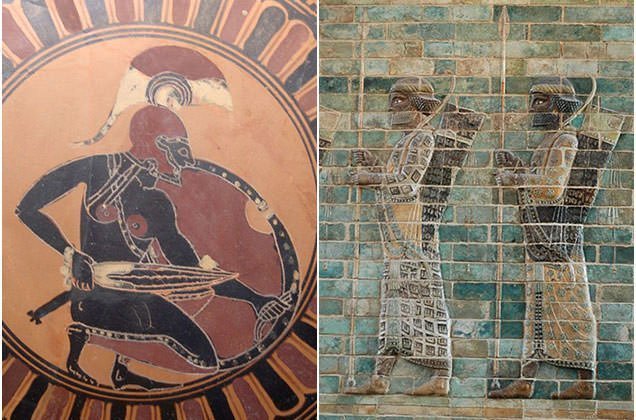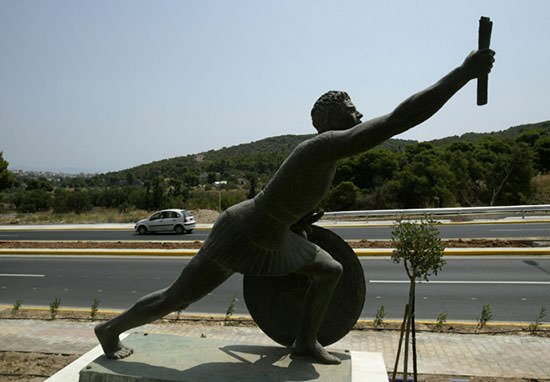The Battle of Marathon was fought between an Athenian army aided by a small force from Plataea and the invading Persian force of Emperor Darius I. Greek victory in the battle ended the first Persian invasion of Greece which had been successful till then. Battle of Marathon was the first major victory of Greece over the Persian Empire and proved to be a turning point in the Greco-Persian Wars. It is considered a highly significant event in European history which allowed the Classical Greek civilization to flourish. There are numerous legends associated with the battle including that of the famous runner Pheidippides, which inspired the modern marathon race. Know more about the causes, events, effects and legends of the historic battle through these 10 interesting facts.
#1 It WAS PRIMARILY CAUSED DUE TO THE IONIAN REVOLT
The Greek cities in the region of Ionia in modern day Turkey came under the Persian Empire since 547 BC. In 499 BC, Greeks in the region revolted in what is known as the Ionian Revolt. The Greek city-states of Athens and Eretria supported the revolt during which parts of the region were burnt by the Greeks including Persian temples in the cities. The Ionian Revolt was ultimately crushed by Persian victory at the Battle of Lade in 494 BC. However, Darius I, king of the Persian Empire, vowed to punish Athens and Eretria for their involvement in the revolt. This led to the First Persian invasion of Greece which began in 492 BC.

#2 ATHENS AND SPARTA EXECUTED PERSIAN AMBASSADORS OF DARIUS I
The first Persian invasion of Greece can be divided into two campaigns. The first campaign took place in 492 BC and was led by Mardonius. During it the Persian force re-conquered Thrace; and forced Macedon, which had been a Persian vassal but retained its general autonomy, to become a fully subordinate part of the Persian Empire. In 491 BC, Persian emperor Darius turned to diplomacy and sent ambassadors to all Greek city states demanding their submission. Though most of the cities submitted, Athens put the ambassadors on trial and executed them while Sparta simply threw them down a well.

#3 THE PERSIAN FORCES WERE LED BY ARTAPHERNES AND DATIS
Darius gave the command of the second campaign of the Persian invasion to Artaphernes, his nephew; and Datis, a Median admiral of the Persian Empire. The fleet sent by Darius consisted of 600 triremes (a type of ancient warship). The strength of the Persian army cannot be stated with certainty. Ancient sources give the figures as high as 200,000 infantry and 10,000 cavalry. Modern historians believe that the infantry was sized in the range of 20,000 – 100,000, with 25,000 the most probable figure; while estimates for the cavalry are in the range of 1,000 – 3,000.

#4 SPARTA DECLINED TO HELP ATHENS AS THE FESTIVAL OF CARNEIA WAS TAKING PLACE
After capturing and destroying the island Naxos, the coastal town Karystos and their first major target Eretria; the Persian forces landed at the bay of Marathon, around 25 miles (40 km) from Athens. The Athenian army quickly marched to block the two exits of the plain of Marathon to prevent the Persians from moving inland. At the same time, Athens sent their greatest runner Pheidippides to Sparta to ask the Spartan army to march to Marathon to aid the Athenian force. However, as the festival of Carneia was taking place, Sparta declined to help till at least ten days, until the full moon rose.
#5 ATHENIAN ARMY WAS ASSISTED BY A FORCE OF 1,000 PLATAEANS
In Athens, ten strategoi or military generals were elected annually. These commanded the Athenian army at Marathon with Miltiades being most prominent due to his experience of fighting the Persians. He is considered the de facto Greek commander-in-chief at Marathon. In addition to strategoi, there was a polemarch or war-leader that had the casting vote. Callimachus was the polemarch at Marathon. The strength of the Athenian force is considered to be around 10,000. It was reinforced by an army of 1,000 from the small city of Plataea; a gesture which won unending Athenian gratitude to Plataea.

#6 THERE WERE FIVE DAYS OF STALEMATE BEFORE THE ACTUAL BATTLE TOOK PLACE
To face the massive Persian army, Athens had to send all its soldiers to Marathon which meant the city couldn’t defend an attack and loss at Marathon would effectively mean a complete defeat of Athens. Thus the Athenian strategy was to keep the Persian army at Marathon by blocking both its exits. Also, delay in battle worked in favour of Athens as it brought the expected arrival of the Spartan army closer. Another important consideration was that the heavily armoured Greeks were vulnerable to attacks by Persian cavalry. Since the Athenians took a strong defensive position at Marathon, the Persians were also reluctant to attack first. This led to five days of stalemate in which neither side attacked.

#7 ATHENIAN FORCES ROUTED THE PERSIAN ARMY AT MARATHON
It was the Athenians who first attacked the Persians despite being outnumbered at least 1:2. The reason for this is not known with certainty but it is most likely that it was due to the temporary absence of the Persian cavalry from their camp. In the ensuing battle, the Greek wings routed the Persian flanks to surround the Persian centre, which had been more successful against Greek’s thin centre. Surrounded by the Greek wings, the Persian centre broke in panic and their men ran towards their ships, pursued by the Greeks. 6,400 Persian bodies were counted on the battlefield; Athens lost just 192 men and Plataea 11.

#8 THE GREEK PHALANX HANDED THEM AN ADVANTAGE IN THE BATTLE
The Greeks used their famous Phalanx formation at the Battle of Marathon. In the Phalanx, men formed a wall of overlapping shields and protruded their spears out from the sides of the shields. The famous Greek shield known as Hoplon was heavier and stronger than that of the Persians. The Phalanx and Hoplon proved to be very effective against the foreign Persians who were not accustomed to them. Also, Athenian general Miltiades is credited for devising tactics in which there were more soldiers in the flanks than at the centre; and for convincing the polemarch to attack at the suitable moment. All these factors are often cited as being responsible for the resounding victory of Greece against a numerically superior enemy.

#9 BATTLE OF MARATHON IS CONSIDERED A PIVOTAL MOMENT IN EUROPEAN HISTORY
Battle of Marathon marked the end of the first Persian invasion of Greece with their force retreating to Asia. However the entire campaign was largely successful with new territories being added to the Persian Empire and the objective of punishing Eretria being realized. Though defeat at Marathon barely dented the enormous Persian Empire, it was a highly significant victory for Athens and all of Greece. It was the first time the Greeks had defeated the Persians and it instilled in them a confidence that would lead to later successes. It also marked the advent of a golden age for Athens. The Battle of Marathon is considered a pivotal moment in European history as the following two centuries saw a rise in the Classical Greek civilization which was highly influential in shaping western society.

#10 THE MARATHON RUN IS BASED ON A MYTH REGARDING THE BATTLE
Various legends are associated with the Battle of Marathon with the most famous one being that of the marathon run. Pheidippides’s run from Athens to Sparta, a distance of over 225 kilometres, has been mentioned before. Also, after the battle, it is said the Persian fleet sailed around Cape Sounion to attack Athens directly. The Athenian army marched at a rapid pace from Marathon to Athens, some 40 kilometers (25 miles), to prevent the attack and complete the Athenian victory. These two accounts later became merged to form the myth that Pheidippides ran from Marathon to Sparta to announce the Athenian victory and died of exhaustion on reaching his destination with his last words being “nenikēkamen!” (we’ve won!). This version of events was propagated when the marathon run, a distance of 25 miles, was introduced at the first modern Olympic Games. It has since been a popular story.

PANIC
Another legend regarding the run of Pheidippides is that while on his way to Sparta to ask for aid Pheidippides was visited by Pan, the Greek god of the wild, shepherds and flocks. Though a peaceful god, when awakened from his noontime nap, Pan was capable of emitting a shout that caused the flocks to stampede. Pan asked Pheidippides why the Athenians didn’t honour him and Pheidippides replied that they would do so from now. Pan believed his word and aided the Athenians in the battle by instilling in the Persians a sudden, mindless, frenzied fear that still bears his name: “panic”. After the battle, the Athenians established a precinct for Pan and offered a sacrifice to him annually.

